Benzoic Acid, Enterococcus faecium, and Essential Oil Complexes Improve Ovarian and Intestinal Health via Modulating Gut Microbiota in Laying Hens Challenged with Clostridium perfringens and Coccidia
Simple Summary
Abstract
1. Introduction
2. Materials and Methods
2.1. Experimental Birds and Study Design
2.2. Histopathology Analysis and Score
2.3. Measurement of Antioxidant Capacity in Jejunal Mucosa and Ovary
2.4. Real-Time PCR for Jejunal Antioxidant-Related mRNA Expression
2.5. Cecal SCFAs Analysis
2.6. Gut Microbiota Sequencing Analysis
2.7. Statistical Analysis
3. Results
3.1. Histopathological Scores and Examination of Intestine and Ovary
3.2. Intestinal and Ovarian Antioxidant Capacities
3.3. SCFAs Concentrations of Cecal Digesta
3.4. Composition and Structure of Cecal Microbial Community
3.5. Correlation Between the Intestinal Health and Cecal Microbiota
4. Discussion
5. Conclusions
Supplementary Materials
Author Contributions
Funding
Institutional Review Board Statement
Informed Consent Statement
Data Availability Statement
Acknowledgments
Conflicts of Interest
References
- Pesti, G.M.; Choct, M. The future of feed formulation for poultry: Toward more sustainable production of meat and eggs. Anim. Nutr. 2023, 15, 71–87. [Google Scholar] [CrossRef] [PubMed]
- Fathima, S.; Hakeem, W.G.A.; Shanmugasundaram, R.; Selvaraj, R.K. Necrotic enteritis in broiler chickens: A review on the pathogen, pathogenesis, and prevention. Microorganisms 2022, 10, 1958. [Google Scholar] [CrossRef] [PubMed]
- Martins, R.R.; Silva, L.J.G.; Pereira, A.M.P.T.; Esteves, A.; Duarte, S.C.; Pena, A. Coccidiostats and poultry: A comprehensive review and current legislation. Foods 2022, 11, 2738. [Google Scholar] [CrossRef]
- Xu, W.; Wang, H.; Liu, L.; Miao, Z.; Huo, Y.; Zhong, Z. Prevalence and characterization of clostridium perfringens isolated from different chicken farms in China. Anaerobe 2021, 72, 102467. [Google Scholar] [CrossRef]
- Emami, N.K.; Dalloul, R.A. Centennial review: Recent developments in host-pathogen interactions during necrotic enteritis in poultry. Poult. Sci. 2021, 100, 101330. [Google Scholar] [CrossRef]
- Bedford, M.R.; Apajalahti, J.H. The influence of nutrition on intestinal disease with emphasis on coccidiosis. Avian Pathol. 2022, 51, 504–520. [Google Scholar] [CrossRef]
- Smyth, J.A.; Mishra, N.; Shivaprasad, H.L. Toxinotyping of clostridium perfringens strains recovered from U.S. turkeys with necrotic enteritis. Avian Dis. 2022, 66, 193–196. [Google Scholar] [CrossRef]
- Mwangi, S.; Timmons, J.; Fitz-Coy, S.; Parveen, S. Characterization of clostridium perfringens recovered from broiler chicken affected by necrotic enteritis. Poult. Sci. 2019, 98, 128–135. [Google Scholar] [CrossRef]
- Badri, M.; Olfatifar, M.; Hayati, A.; Bijani, B.; Samimi, R.; Abdoli, A.; Nowak, O.; Diaz, D.; Eslahi, A.V. The global prevalence and associated risk factors of Eimeria infection in domestic chickens: A systematic review and meta-analysis. Vet. Med. Sci. 2024, 10, e1469. [Google Scholar] [CrossRef]
- Gržinić, G.; Piotrowicz-Cieślak, A.; Klimkowicz-Pawlas, A.; Górny, R.L.; Ławniczek-Wałczyk, A.; Piechowicz, L.; Olkowska, E.; Potrykus, M.; Tankiewicz, M.; Krupka, M.; et al. Intensive poultry farming: A review of the impact on the environment and human health. Sci. Total. Environ. 2023, 858, 160014. [Google Scholar] [CrossRef]
- Manikandan, M.; Chun, S.; Kazibwe, Z.; Gopal, J.; Singh, U.B.; Oh, J.W. Phenomenal bombardment of antibiotic in poultry: Contemplating the environmental repercussions. Int. J. Environ. Res. Public Health. 2020, 17, 5053. [Google Scholar] [CrossRef] [PubMed]
- Swaggerty, C.L.; Bortoluzzi, C.; Lee, A.; Eyng, C.; Pont, G.D.; Kogut, M.H. Potential replacements for antibiotic growth promoters in poultry: Interactions at the gut level and their impact on host immunity. Adv. Exp. Med. Biol. 2022, 1354, 145–159. [Google Scholar] [PubMed]
- Castanon, J.I.R. History of the use of antibiotic as growth promoters in european poultry feeds. Poult. Sci. 2007, 86, 2466–2471. [Google Scholar] [CrossRef] [PubMed]
- Salim, H.M.; Huque, K.S.; Kamaruddin, K.M.; Beg, M.D.A.H. Global restriction of using antibiotic growth promoters and alternative strategies in poultry production. Sci. Prog. 2018, 101, 52–75. [Google Scholar] [CrossRef] [PubMed]
- Sugiharto, S. Role of nutraceuticals in gut health and growth performance of poultry. J. Saudi Soc. Agric. Sci. 2016, 15, 99–111. [Google Scholar] [CrossRef]
- Adhikari, P.A.; Cosby, D.E.; Cox, N.A.; Lee, J.H.; Kim, W.K. Effect of dietary bacteriophage supplementation on internal organs, fecal excretion, and ileal immune response in laying hens challenged by Salmonella Enteritidis. Poult. Sci. 2017, 96, 3264–3271. [Google Scholar] [CrossRef]
- Cui, X.; Zhang, S.; Jiang, S.; Gou, Z.; Wang, Y. Dietary protocatechuic acid ameliorates ileal mucosal barrier injury and inflammatory response and improves intestinal microbiota composition in yellow chickens challenged with Salmonella typhimurium. Poult. Sci. 2023, 102, 102496. [Google Scholar] [CrossRef]
- Bortoluzzi, C.; Bittencourt, L.C.; Perez-Calvo, E.; Belote, B.L.; Soares, I.; Santin, E.; Sorbara, J.O.B.; Caron, L.F. A microbial muramidase improves growth performance and reduces inflammatory cell infiltration in the intestine of broilers chickens under Eimeria and Clostridium perfringens challenge. Poult. Sci. 2024, 103, 103226. [Google Scholar] [CrossRef]
- Wu, Y.; Zhen, W.; Geng, Y.; Wang, Z.; Guo, Y. Pretreatment with probiotic Enterococcus faecium NCIMB 11181 ameliorates necrotic enteritis-induced intestinal barrier injury in broiler chickens. Sci. Rep. 2019, 9, 10256. [Google Scholar] [CrossRef]
- Pham, V.H.; Kan, L.; Huang, J.; Geng, Y.; Zhen, W.; Guo, Y.; Abbas, W.; Wang, Z. Dietary encapsulated essential oils and organic acids mixture improves gut health in broiler chickens challenged with necrotic enteritis. J. Anim. Sci. Biotechnol. 2020, 11, 18. [Google Scholar] [CrossRef]
- Pham, V.H.; Abbas, W.; Huang, J.; He, Q.; Zhen, W.; Guo, Y.; Wang, Z. Effect of blending encapsulated essential oils and organic acids as an antibiotic growth promoter alternative on growth performance and intestinal health in broilers with necrotic enteritis. Poult. Sci. 2022, 101, 101563. [Google Scholar] [CrossRef] [PubMed]
- Zhang, H.; Ding, X.; Bai, S.; Zeng, Q.; Zhang, K.; Mao, X.; Chu, L.; Hou, D.; Xuan, Y.; Wang, J. Alleviating effect of dietary supplementation of benzoic acid, Enterococcus faecium and essential oil complex on coccidia and Clostridium perfringens challenge in laying hens. Poult. Sci. 2022, 101, 101720. [Google Scholar] [CrossRef] [PubMed]
- Zhang, H.; Li, M.; Zhang, K.; Ding, X.; Bai, S.; Zeng, Q.; Chu, L.; Hou, D.; Xuan, Y.; Yin, H.; et al. Effect of benzoic acid, Enterococcus faecium, and essential oil complex on intestinal microbiota of laying hens under coccidia and Clostridium perfringens challenge. Poult. Sci. 2023, 102, 102490. [Google Scholar] [CrossRef] [PubMed]
- National Research Council (NRC). Nutrient Requirements of Poultry, 9th ed.; National Academy Press: Washington, DC, USA, 1994. [Google Scholar]
- Shojadoost, B.; Vince, A.R.; Prescott, J.F. The successful experimental induction of necrotic enteritis in chickens by Clostridium perfringens: A critical review. Vet Res. 2012, 43, 74. [Google Scholar] [CrossRef] [PubMed]
- Tang, B.; Pors, S.E.; Kristensen, B.M.; Skjerning, R.B.J.; Olsen, R.H.; Bojesen, A.M. GtxA is a virulence factor that promotes a Th2-like response during Gallibacterium anatis infection in laying hens. Vet Res. 2020, 51, 40. [Google Scholar] [CrossRef]
- Timbermont, L.; Haesebrouck, F.; Ducatelle, R.; Van Immerseel, F. Necrotic enteritis in broilers: An updated review on the pathogenesis. Avian Pathol. 2011, 40, 341–347. [Google Scholar] [CrossRef]
- Li, J.; Adams, V.; Bannam, T.L.; Miyamoto, K.; Garcia, J.P.; Uzal, F.A.; Rood, J.I.; McClane, B.A. Toxin plasmids of Clostridium perfringens. Microbiol. Mol. Biol. Rev. 2013, 77, 208–233. [Google Scholar] [CrossRef]
- Barbalho, R.L.D.C.; Castaneda, C.; Araújo, L.F.; Kiess, A.S.; Carvalho, R.S.B.; Barbalho, C.B.; Borges, L.L.; Bonato, M.A. Β-glucans and MOS, essential oil, and probiotics in diets of broilers challenged with Eimeria spp. and Clostridium perfringens. Poult. Sci. 2023, 102, 102541. [Google Scholar] [CrossRef]
- Gadde, U.; Kim, W.H.; Oh, S.T.; Lillehoj, H.S. Alternatives to antibiotics for maximizing growth performance and feed efficiency in poultry: A review. Anim. Health. Res. Rev. 2017, 18, 26–45. [Google Scholar] [CrossRef]
- Wang, H.; Ni, X.; Liu, L.; Zeng, D.; Lai, J.; Qing, X.; Li, G.; Pan, K.; Jing, B. Controlling of growth performance, lipid deposits and fatty acid composition of chicken meat through a probiotic, lactobacillus johnsonii during subclinical Clostridium perfringens infection. Lipids Health Dis. 2017, 16, 38. [Google Scholar] [CrossRef]
- Kumar, A.; Toghyani, M.; Kheravii, S.K.; Pineda, L.; Han, Y.; Swick, R.A.; Wu, S.B. Potential of blended organic acids to improve performance and health of broilers infected with necrotic enteritis. Anim. Nutr. 2021, 7, 440–449. [Google Scholar] [CrossRef] [PubMed]
- Caly, D.L.; D’Inca, R.; Auclair, E.; Drider, D. Alternatives to antibiotics to prevent necrotic enteritis in broiler chickens: A microbiologist’s perspective. Front. Microbiol. 2015, 6, 1336. [Google Scholar] [CrossRef] [PubMed]
- Mao, X.; Dou, Y.; Fan, X.; Yu, B.; He, J.; Zheng, P.; Yu, J.; Luo, J.; Luo, Y.; Yan, H.; et al. The effect of dietary Yucca schidigera extract supplementation on productive performance, egg quality, and gut health in laying hens with Clostridium perfringens and coccidia challenge. Poult. Sci. 2022, 102, 102822. [Google Scholar] [CrossRef]
- Awad, W.A.; Hess, C.; Hess, M. Enteric pathogens and their toxin-induced disruption of the intestinal barrier through alteration of tight junctions in chickens. Toxins 2017, 9, 60. [Google Scholar] [CrossRef]
- Levkut, M.; Revajová, V.; Lauková, A.; Ševčíková, Z.; Spišáková, V.; Faixová, Z.; Levkutová, M.; Strompfová, V.; Pistl, J.; Levkut, M. Leukocytic responses and intestinal mucin dynamics of broilers protected with Enterococcus faecium EF55 and challenged with Salmonella Enteritidis. Res. Vet. Sci. 2012, 93, 195–201. [Google Scholar] [CrossRef]
- Yang, X.; Liu, Y.; Yan, F.; Yang, C.; Yang, X. Effects of encapsulated organic acids and essential oils on intestinal barrier, microbial count, and bacterial metabolites in broiler chickens. Poult. Sci. 2019, 98, 2858–2865. [Google Scholar] [CrossRef]
- Fukai, T.; Ushio-Fukai, M. Superoxide dismutases: Role in redox signaling, vascular function, and diseases. Antioxid. Redox. Signal. 2011, 15, 1583–1606. [Google Scholar] [CrossRef]
- Wang, J.; Jia, R.; Gong, H.; Celi, P.; Zhuo, Y.; Ding, X.; Bai, S.; Zen, Q.; Yin, H.; Xu, S.; et al. The effect of oxidative stress on the chicken ovary: Involvement of microbiota and melatonin interventions. Antioxidants 2021, 10, 1422. [Google Scholar] [CrossRef]
- Gu, Y.F.; Chen, Y.P.; Jin, R.; Wang, C.; Wen, C.; Zhou, Y.M. Dietary chitooligosaccharide supplementation alleviates intestinal barrier damage, and oxidative and immunological stress in lipopolysaccharide-challenged laying hens. Poult. Sci. 2022, 101, 101701. [Google Scholar] [CrossRef]
- Pisoschi, A.M.; Pop, A. The role of antioxidants in the chemistry of oxidative stress: A review. Eur. J. Med. Chem. 2015, 97, 55–74. [Google Scholar] [CrossRef]
- Purdom-Dickinson, S.E.; Sheveleva, E.V.; Sun, H.; Chen, Q.M. Translational control of Nrf2 protein in activation of antioxidant response by oxidants. Mol. Pharmacol. 2007, 72, 1074–1081. [Google Scholar] [CrossRef] [PubMed]
- Wang, Y.; Wang, Y.; Lin, X.; Gou, Z.; Fan, Q.; Ye, J.; Jiang, S. Potential effects of acidifier and amylase as substitutes for antibiotic on the growth performance, nutrient digestion and gut microbiota in yellow-feathered broilers. Animals 2020, 10, 1858. [Google Scholar] [CrossRef] [PubMed]
- Broom, L.J.; Kogut, M.H. The role of the gut microbiome in shaping the immune system of chickens. Vet. Immunol. Immunopathol. 2018, 204, 44–51. [Google Scholar] [CrossRef] [PubMed]
- Chen, L.; Bai, X.; Wang, T.; Liu, J.; Miao, X.; Zeng, B.; Li, D. Gut microbial diversity analysis of different native chickens and screening of chicken-derived probiotics. Animals 2023, 13, 3672. [Google Scholar] [CrossRef] [PubMed]
- Gibiino, G.; Lopetuso, L.R.; Scaldaferri, F.; Rizzatti, G.; Binda, C.; Gasbarrini, A. Exploring bacteroidetes: Metabolic key points and immunological tricks of our gut commensals. Dig. Liver Dis. 2018, 50, 635–639. [Google Scholar] [CrossRef]
- Zeng, M.Y.; Inohara, N.; Nuñez, G. Mechanisms of inflammation-driven bacterial dysbiosis in the gut. Mucosal Immunol. 2017, 10, 18–26. [Google Scholar] [CrossRef]
- Liu, Y.; Li, L.; Yan, H.; Ning, Z.; Wang, Z. Lactobacillus salivarius SNK-6 activates intestinal mucosal immune system by regulating cecal microbial community structure in laying hens. Microorganisms 2022, 10, 1469. [Google Scholar] [CrossRef]
- Zhao, J.; Bai, M.; Ning, X.; Qin, Y.; Wang, Y.; Yu, Z.; Dong, R.; Zhang, Y.; Sun, S. Expansion of Escherichia-Shigella in gut is associated with the onset and response to immunosuppressive therapy of IgA nephropathy. J. Am. Soc. Nephrol. 2022, 33, 2276–2292. [Google Scholar] [CrossRef]
- Xu, Y.Q.; Zhu, Y.; Li, X.; Sun, B.G. Dynamic balancing of intestinal short-chain fatty acids: The crucial role of bacterial metabolism. Trends. Food. Sci. Technol. 2020, 100, 118–130. [Google Scholar] [CrossRef]
- Jasim, S.A.; Opulencia, M.J.C.; Ramírez-Coronel, A.A.; Abdelbasset, W.K.; Abed, M.H.; Markov, A.; Lateef Al-Awsi, G.R.; Azamatovich Shamsiev, J.; Hammid, A.T.; Shalaby, M.N.; et al. The emerging role of microbiota-derived short-chain fatty acids in immunometabolism. Int Immunopharmacol. 2022, 110, 108983. [Google Scholar] [CrossRef]
- Khorsand, B.; Asadzadeh Aghdaei, H.; Nazemalhosseini-Mojarad, E.; Nadalian, B.; Nadalian, B.; Houri, H. Overrepresentation of Enterobacteriaceae and Escherichia coli is the major gut microbiome signature in Crohn’s disease and ulcerative colitis; a comprehensive metagenomic analysis of IBDMDB datasets. Front. Cell. Infect. Microbiol. 2022, 12, 1015890. [Google Scholar] [CrossRef] [PubMed]
- Abd El-Hack, M.E.; El-Saadony, M.T.; Alqhtani, A.H.; Swelum, A.A.; Salem, H.M.; Elbestawy, A.R.; Noreldin, A.E.; Babalghith, A.O.; Khafaga, A.F.; Hassan, M.I.; et al. The relationship among avian influenza, gut microbiota and chicken immunity: An updated overview. Poult. Sci. 2022, 101, 102021. [Google Scholar] [CrossRef] [PubMed]
- Bi, R.; Yang, M.; Liu, X.; Guo, F.; Hu, Z.; Huang, J.; Abbas, W.; Xu, T.; Liu, W.; Wang, Z. Effects of chlorogenic acid on productive and reproductive performances, egg quality, antioxidant functions, and intestinal microenvironment in aged breeder laying hens. Poult. Sci. 2024, 103, 104060. [Google Scholar] [CrossRef] [PubMed]
- Wang, L.; Gou, X.; Ding, Y.; Liu, J.; Wang, Y.; Wang, Y.; Zhang, J.; Du, L.; Peng, W.; Fan, G. The interplay between herbal medicines and gut microbiota in metabolic diseases. Front. Pharmacol. 2023, 14, 1105405. [Google Scholar] [CrossRef]
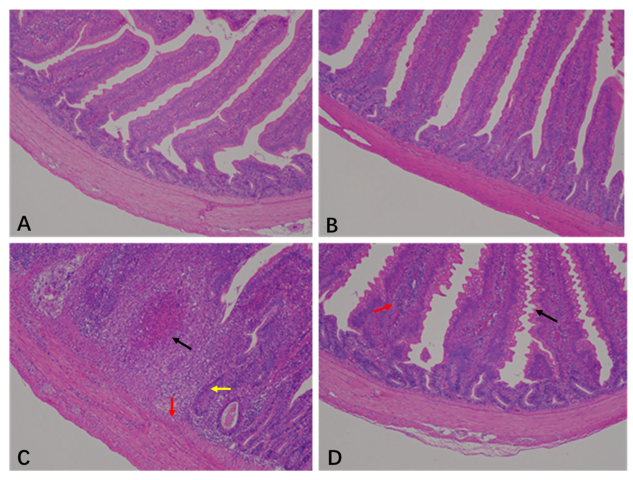
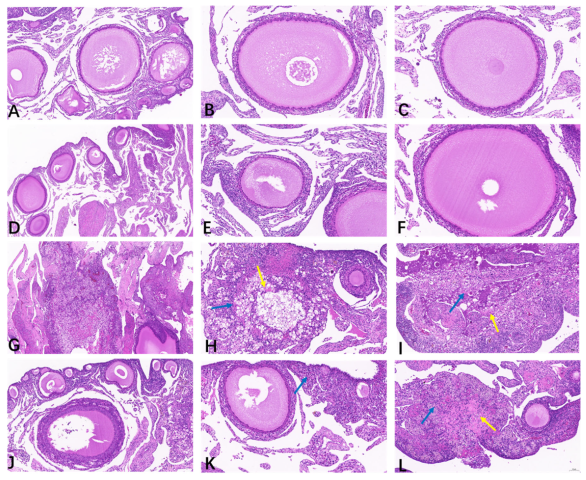
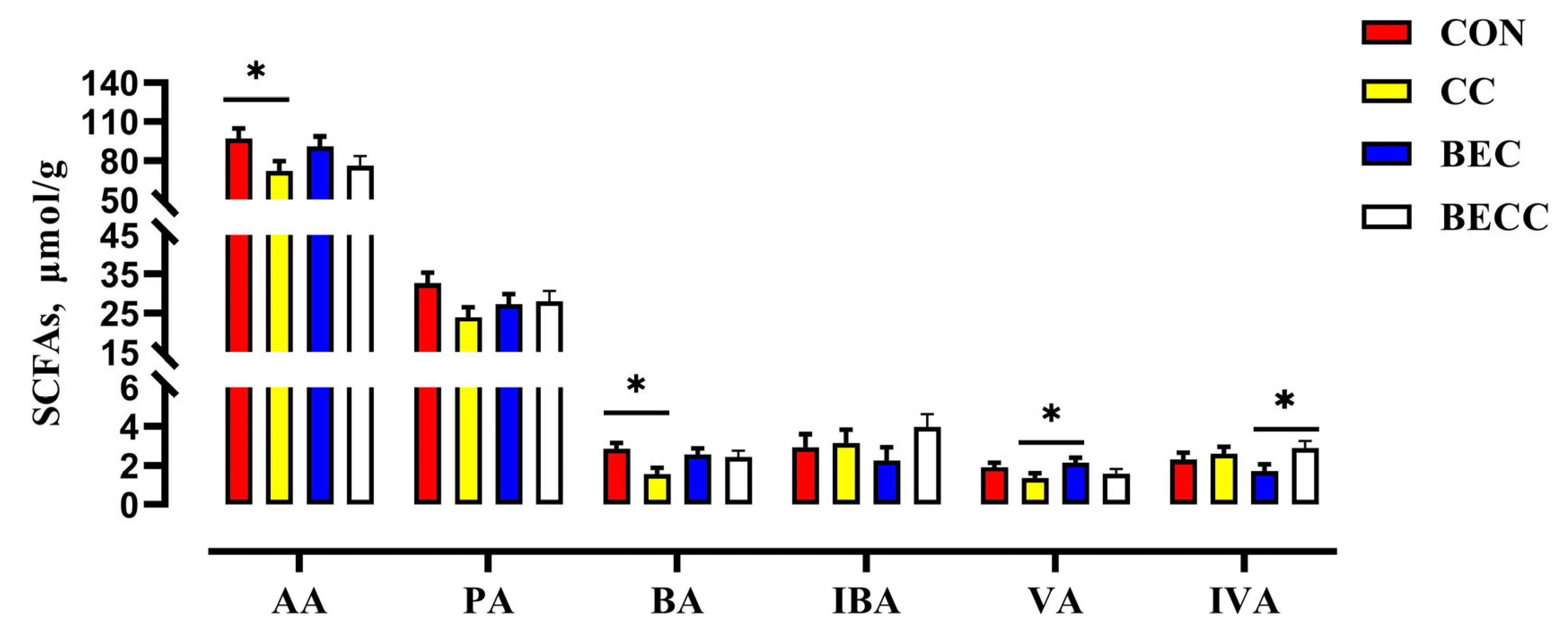
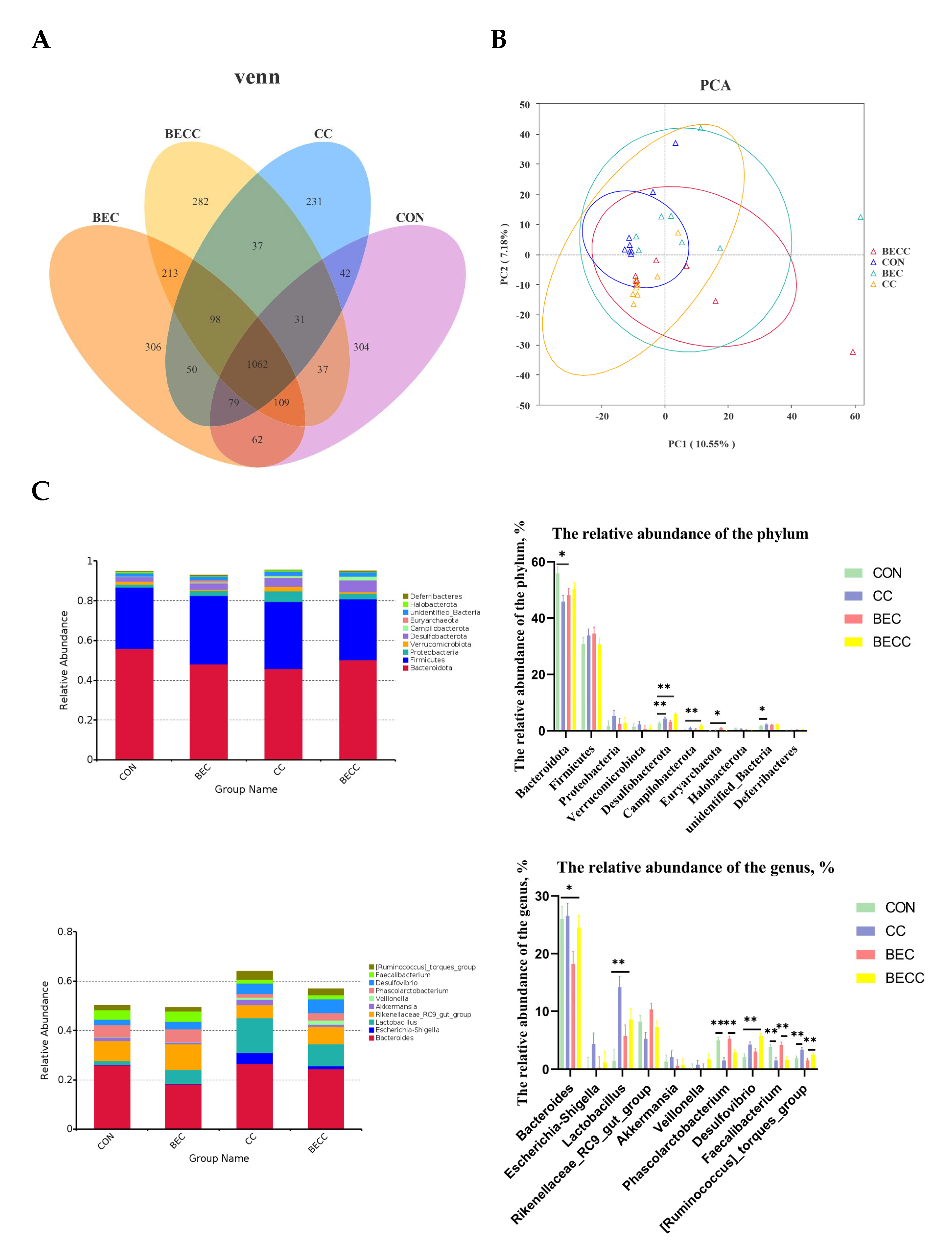
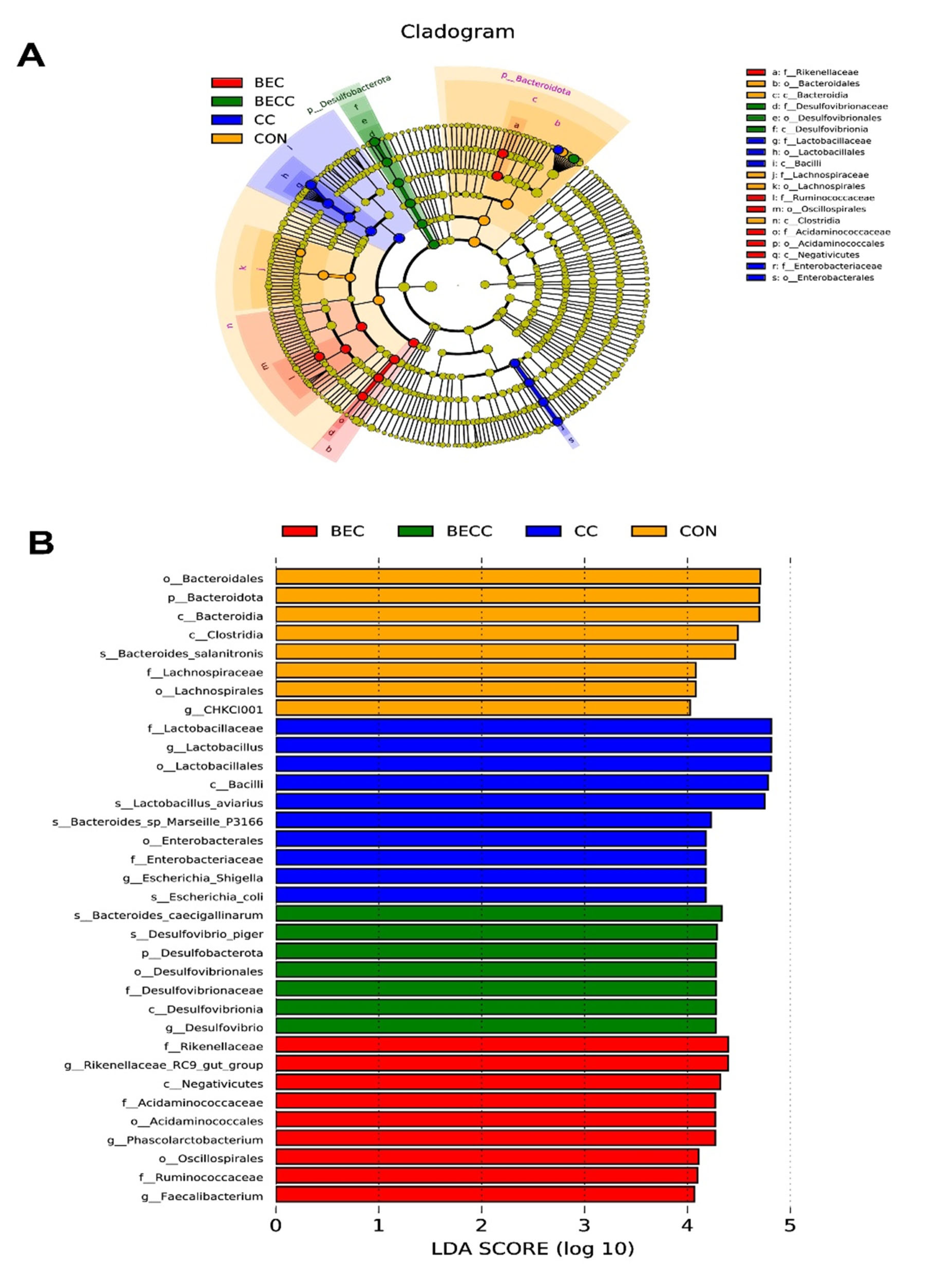

| Item 1 | Jejunum | Ovary |
|---|---|---|
| CON | 0.50c | 0.25 a |
| CC | 4.50a | 4.75 c |
| BEC | 0.38c | 0.5 a |
| BECC | 3.25b | 4.13 b |
| SEM | 0.23 | 0.19 |
| p-value | <0.01 | <0.01 |
| Main effect p-value | ||
| BEC | 0.02 | 0.03 |
| CC | <0.01 | <0.01 |
| CC*BEC | <0.01 | 0.33 |
| Item 1,2 | SOD, U/mg | CAT, U/mg | GSH, U/mg | GSH-PX, U/mg | GSH-ST, U/mg | T-AOC, U/mg | MDA, nmol/mg |
|---|---|---|---|---|---|---|---|
| CON | 104.35 b | 23.39 b | 37.31 b | 79.39 | 29.48 b | 1.21 ab | 1.22 b |
| CC | 432.57 a | 82.33 a | 88.46 a | 97.95 | 244.80 a | 2.31 a | 10.62 a |
| BEC | 89.94 b | 28.06 b | 19.65 b | 76.40 | 40.05 b | 0.95 b | 1.60 b |
| BECC | 276.45 ab | 43.68 ab | 45.56 b | 127.06 | 113.01 ab | 2.25 a | 5.31 b |
| SEM | 31.36 | 15.25 | 11.09 | 25.57 | 45.85 | 0.36 | 1.72 |
| p-value | <0.01 | 0.05 | <0.01 | 0.49 | 0.01 | 0.02 | <0.01 |
| Main effect p-value | |||||||
| BEC | 0.18 | 0.27 | 0.01 | 0.62 | 0.20 | 0.66 | 0.17 |
| CC | <0.01 | 0.02 | <0.01 | 0.19 | <0.01 | <0.01 | <0.01 |
| CC*BEC | 0.26 | 0.17 | 0.27 | 0.54 | 0.14 | 0.79 | 0.11 |
| Item 1,2 | Nrf2 | Keap1 | NQO1 | HO-1 | NF-κB | P53 |
|---|---|---|---|---|---|---|
| CON | 1.00 b | 1.00 a | 1.00 b | 1.00 ab | 1.00 | 1.00 bc |
| CC | 0.64 b | 0.39 b | 0.57 b | 0.63 b | 0.67 | 0.51 c |
| BEC | 2.10 a | 0.64 ab | 1.63 a | 1.27 a | 2.26 | 1.92 a |
| BECC | 0.69 b | 0.35 b | 0.68 b | 0.59 b | 0.69 | 1.36 ab |
| SEM | 0.22 | 0.18 | 0.15 | 0.14 | 0.55 | 0.27 |
| p-value | <0.01 | 0.07 | <0.01 | <0.01 | 0.16 | <0.01 |
| Main effect | ||||||
| p-value | ||||||
| BEC | 0.02 | 0.30 | 0.02 | 0.42 | 0.25 | <0.01 |
| CC | <0.01 | 0.02 | <0.01 | <0.01 | 0.09 | 0.06 |
| CC*BEC | 0.04 | 0.41 | 0.10 | 0.31 | 0.27 | 0.88 |
| Item 1,2 | SOD, U/mg | CAT, U/mg | GSH, U/mg | GSH-PX, U/mg | GSH-ST, U/mg | T-AOC, U/mg | MDA, nmol/mg |
|---|---|---|---|---|---|---|---|
| CON | 211.08 | 11.50 | 10.06 | 113.11 | 58.56 | 0.74 | 2.23 bc |
| CC | 217.69 | 7.26 | 15.29 | 98.09 | 54.48 | 2.21 | 3.86 ab |
| BEC | 219.49 | 9.27 | 9.41 | 106.68 | 50.82 | 0.96 | 1.63 c |
| BECC | 219.32 | 6.38 | 12.16 | 99.47 | 54.40 | 0.90 | 4.63 a |
| SEM | 13.42 | 1.45 | 2.47 | 8.14 | 6.56 | 0.53 | 0.71 |
| p-value | 0.97 | 0.09 | 0.35 | 0.54 | 0.87 | 0.21 | 0.02 |
| Main effect p-value | |||||||
| BEC | 0.71 | 0.29 | 0.45 | 0.76 | 0.56 | 0.32 | 0.90 |
| CC | 0.81 | 0.02 | 0.12 | 0.19 | 0.97 | 0.20 | <0.01 |
| CC*BEC | 0.80 | 0.64 | 0.62 | 0.64 | 0.56 | 0.16 | 0.35 |
| Item 1 | Observed Species | Shannon | Simpson | Chao1 | ACE |
|---|---|---|---|---|---|
| CON | 810.88 ab | 6.84 b | 0.98 a | 868.61 | 879.28 |
| CC | 747.50 b | 6.28 c | 0.95 b | 813.42 | 828.61 |
| BEC | 950.88 a | 7.24 a | 0.98 a | 1020.78 | 1034.1 |
| BECC | 840.75 ab | 6.59 bc | 0.97 a | 909.49 | 919.49 |
| SEM | 46.27 | 0.13 | 0.01 | 53.68 | 54.34 |
| p-value | 0.03 | <0.01 | <0.01 | 0.06 | 0.07 |
| Main effect p-value | |||||
| BEC | 0.02 | 0.01 | 0.03 | 0.02 | 0.03 |
| CC | 0.07 | <0.01 | <0.01 | 0.13 | 0.13 |
| CC*BEC | 0.62 | 0.73 | 0.45 | 0.60 | 0.56 |
Disclaimer/Publisher’s Note: The statements, opinions and data contained in all publications are solely those of the individual author(s) and contributor(s) and not of MDPI and/or the editor(s). MDPI and/or the editor(s) disclaim responsibility for any injury to people or property resulting from any ideas, methods, instructions or products referred to in the content. |
© 2025 by the authors. Licensee MDPI, Basel, Switzerland. This article is an open access article distributed under the terms and conditions of the Creative Commons Attribution (CC BY) license (https://creativecommons.org/licenses/by/4.0/).
Share and Cite
Zhang, H.; Liang, F.; Gong, H.; Mao, X.; Ding, X.; Bai, S.; Zeng, Q.; Xuan, Y.; Zhang, K.; Wang, J. Benzoic Acid, Enterococcus faecium, and Essential Oil Complexes Improve Ovarian and Intestinal Health via Modulating Gut Microbiota in Laying Hens Challenged with Clostridium perfringens and Coccidia. Animals 2025, 15, 299. https://doi.org/10.3390/ani15030299
Zhang H, Liang F, Gong H, Mao X, Ding X, Bai S, Zeng Q, Xuan Y, Zhang K, Wang J. Benzoic Acid, Enterococcus faecium, and Essential Oil Complexes Improve Ovarian and Intestinal Health via Modulating Gut Microbiota in Laying Hens Challenged with Clostridium perfringens and Coccidia. Animals. 2025; 15(3):299. https://doi.org/10.3390/ani15030299
Chicago/Turabian StyleZhang, Hongye, Fengjia Liang, Haojie Gong, Xiangbing Mao, Xuemei Ding, Shiping Bai, Qiufeng Zeng, Yue Xuan, Keying Zhang, and Jianping Wang. 2025. "Benzoic Acid, Enterococcus faecium, and Essential Oil Complexes Improve Ovarian and Intestinal Health via Modulating Gut Microbiota in Laying Hens Challenged with Clostridium perfringens and Coccidia" Animals 15, no. 3: 299. https://doi.org/10.3390/ani15030299
APA StyleZhang, H., Liang, F., Gong, H., Mao, X., Ding, X., Bai, S., Zeng, Q., Xuan, Y., Zhang, K., & Wang, J. (2025). Benzoic Acid, Enterococcus faecium, and Essential Oil Complexes Improve Ovarian and Intestinal Health via Modulating Gut Microbiota in Laying Hens Challenged with Clostridium perfringens and Coccidia. Animals, 15(3), 299. https://doi.org/10.3390/ani15030299






